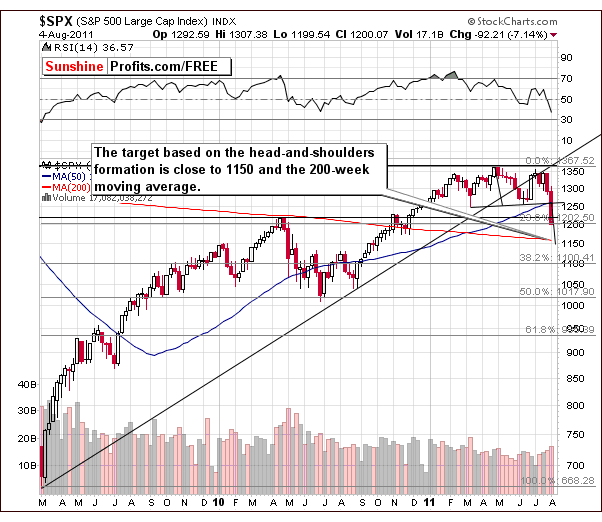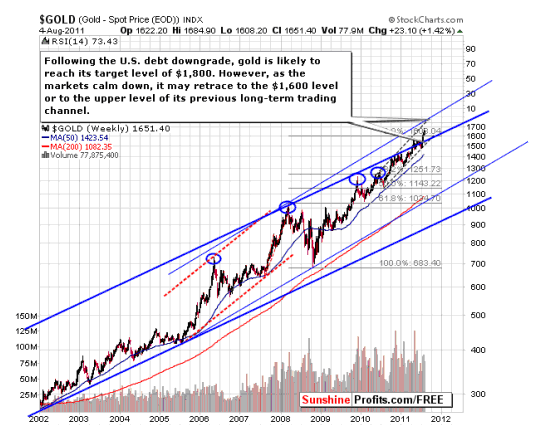Is Gold Still AAA?
http://www.gold-eagle.com/editorials_08/radomski081011.html
Nearly two weeks ago, in our essay on gold and debt ceiling, we wrote the following:
The [debt ceiling] stalemate may cost America its AAA rating, adding $100 billion a year to government costs while dragging down economic growth.
As a matter of fact, on Friday the S&P rating agency downgraded the U.S. credit rating from AAA to AA+. This is an unprecedented event and because of that the effects are unclear as far as the stock market is concerned. In the long term they are unclear because on one hand it's obvious that the credit downgrade will make U.S. securities more risky and thus less attractive to foreign investors, but on the other hand we know that when Canada lost its AAA rating in April 1993, Canadian stocks rallied more than 15% in the subsequent year. Japanese stocks moved over 25% higher in the 12 months after Moody's downgraded Japan in November 1998.
In the short term the situation is complicated because some of this information might have already been factored in in previous price levels and we could have the "buy the rumor, sell the fact" type of event, which in this case would mean "sell the rumor, buy the fact".
Speaking of facts, let's start with them. The U.S. has been downgraded from AAA to AA+. From S&P website we get the following definitions:
'AAA' - Extremely strong capacity to meet financial commitments. Highest Rating. 'AA' - Very strong capacity to meet financial commitments.
Note: Ratings from 'AA' to 'CCC' may be modified by the addition of a plus (+) or minus (-) sign to show relative standing within the major rating categories.
Additional facts are:
- Moody's and Fitch did not change their top credit rating for the U.S.
- Credit ratings are used for calculating required rate of return (lower rating -> bigger risk -> bigger payoff required for taking this additional risk called the risk premium) and this means that they directly related to US debt securities and indirectly to other US securities as well.
So, the U.S. has not been downgraded to "junk" status (like Greece), it's been downgraded from extremely strong to very strong. This will have a small impact on the risk premiums - perhaps 0.38% (compare country risk premium between Aaa and Aa1 countries on this website). So, the logical approach suggests that not much should change - after all, this is a slight change of view on the U.S. credit, and a change of view expressed by only one rating agency.
On the other hand, it's the world's biggest economic superpower that's no longer top notch and it seems that this action will make many investors sell their "riskless Treasuries" and buy other countries' notes/bonds or precious metals instead. There's a lot of fear in the marketplace as the traditional safe bet (Treasuries) doesn't appear as safe as it used to. This creates a potentially positive environment for gold.
To determine whether the outlook for metals is in fact positive, let's move on to the technical part of today's essay. We will start with the medium-term S&P 500 Index chart (charts courtesy by http://stockcharts.com).

Declines seen on Thursday and Friday were followed by a huge move down on Monday triggered by the U.S. debt downgrade. These observations lead us to the obvious question of whether the decline will last longer. At this point, the situation is very unclear, however based on Tuesday's strong rebound after stocks touched the 38.2% Fibonacci retracement level visible on the above chart, 50-week moving average and other factors, it seems that at least a local bottom has been formed.
This doesn't paint an overly bullish picture for gold for the following weeks, as it has been negatively correlated with the main stock indices. In other words, gold's rally can be to a large extent explained by the increased fear among stock investors who dumped their holdings to buy gold. The US downgrade has increased the tension.

With stocks perhaps at a local bottom, it seems that gold may form a short-term top soon.
This becomes extremely important when you take into account the above long-term chart and realize that right now gold is on the brink of $1,800. Yes, we were bullish on gold just a few days ago, but that was also many tens of dollars ago. With this volatility things can change very quickly.
Once the first shock is over, we may see markets come to their senses and accept the fact that an AA+ rating for the U.S. debt is far from bad. Once they do that, gold is likely to move lower, even though the long-term situation has just (low interest rates at least until mid-2013) become even more favorable.
Summing up, the U.S. rating downgrade resulted in declines in the general stock market and took the indices much lower. However, AA+ rating is not the end of the world and investors may soon realize that have overreacted. Was the final bottom reached? That is still unclear, however at least a short-term move higher appears likely. Meanwhile, fueled by fear, gold might move just a little higher, but as soon as things calm down, the yellow metal is likely to decline - likely after topping close to $1,800.
Recent GOLD News
- Higher Q2 Production Puts Barrick On Track to Deliver 2024 Targets • GlobeNewswire Inc. • 07/16/2024 11:00:00 AM
- Barrick Continues to Invest in Mali • GlobeNewswire Inc. • 07/09/2024 07:00:00 PM
- Exploration Success, Capital Investment and Reserve Growth to Sustain Kibali’s Production Profile • GlobeNewswire Inc. • 07/02/2024 04:00:00 PM
- Barrick and Zijin Contribute $1 Million to Support Papua New Guinea Landslide Victims • GlobeNewswire Inc. • 06/07/2024 11:18:39 AM
- Form SD - Specialized disclosure report • Edgar (US Regulatory) • 05/29/2024 08:01:04 PM
- Barrick’s Sustainability Strategy Delivers Real Value to Stakeholders • GlobeNewswire Inc. • 05/15/2024 11:00:00 AM
- Barrick Announces Extensive Exploration Partnership with Geophysx Jamaica • GlobeNewswire Inc. • 05/01/2024 10:15:00 AM
- Barrick to Ramp Up Production As It Remains On Track to Achieve 2024 Targets • GlobeNewswire Inc. • 05/01/2024 10:00:00 AM
- Barrick Declares Q1 Dividend • GlobeNewswire Inc. • 05/01/2024 09:59:00 AM
- Barrick Announces Election of Directors • GlobeNewswire Inc. • 04/30/2024 08:15:55 PM
- Barrick On Track to Achieve 2024 Targets • GlobeNewswire Inc. • 04/16/2024 11:00:00 AM
- Notice of Release of Barrick’s First Quarter 2024 Results • GlobeNewswire Inc. • 04/09/2024 11:00:00 AM
- Strategy-Driven Barrick Builds on Value Foundation • GlobeNewswire Inc. • 03/28/2024 09:20:38 PM
- Barrick Hunts New Gold and Copper Prospects in DRC From Kibali Base • GlobeNewswire Inc. • 03/20/2024 02:00:00 PM
- Barrick Opens Academy at Closed Buzwagi Mine • GlobeNewswire Inc. • 03/18/2024 08:00:00 AM
- Barrick to Grow Production and Value on Global Asset Foundation • GlobeNewswire Inc. • 03/15/2024 11:53:01 AM
- Loulo-Gounkoto Delivers Another Value-Creating Performance • GlobeNewswire Inc. • 03/10/2024 10:00:00 AM
- Passing of the Right Honorable Brian Mulroney • GlobeNewswire Inc. • 03/02/2024 01:17:35 AM
- Kibali and DRC Partner to Promote Local Content • GlobeNewswire Inc. • 03/01/2024 02:22:43 PM
- Tanzanian Parliamentary Committee Lauds Barrick’s Work at North Mara • GlobeNewswire Inc. • 02/23/2024 12:00:00 PM
- Form 6-K - Report of foreign issuer [Rules 13a-16 and 15d-16] • Edgar (US Regulatory) • 02/14/2024 10:28:08 PM
- Form 6-K - Report of foreign issuer [Rules 13a-16 and 15d-16] • Edgar (US Regulatory) • 02/14/2024 08:05:25 PM
- Clear Strategies and Strong Partnerships Set Barrick Up to Outperform, Says Bristow • GlobeNewswire Inc. • 02/14/2024 11:00:00 AM
- Barrick Announces New Share Buyback Program • GlobeNewswire Inc. • 02/14/2024 10:59:00 AM
- Barrick Declares Q4 Dividend • GlobeNewswire Inc. • 02/14/2024 10:58:00 AM
FEATURED North Bay Resources Acquires Mt. Vernon Gold Mine, Sierra County, California, with Assays up to 4.8 oz. Au per Ton • Jul 18, 2024 9:00 AM
VAYK Expects Revenue from First Airbnb Property Starting from August • VAYK • Jul 18, 2024 9:00 AM
Nightfood Holdings Signs Letter of Intent for All-Stock Acquisition of CarryOutSupplies.com • NGTF • Jul 17, 2024 1:00 PM
Kona Gold Beverages Reaches Out to Largest Debt Holder for Debt Purchase Negotiation • KGKG • Jul 17, 2024 9:00 AM
Avant Technologies Welcomes Back Former CEO with Eye Toward Future Growth and Expansion • AVAI • Jul 17, 2024 8:00 AM
HealthLynked Expands Telemedicine Nationwide • HLYK • Jul 17, 2024 8:00 AM






